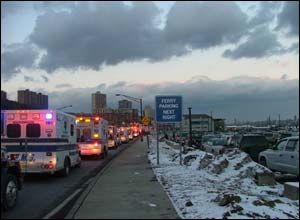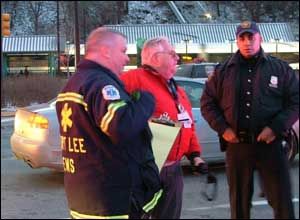 |
By Steven P. Velasquez, MICP
Robert Wood Johnson University Hospital
 Photo by Steve Velasquez, MICP Members of the NJ task force arrive at Port Imperale in NJ as part of a massive response to the US Airways plane crash Thursday. Many consider the response to be “flawless.” |
So how does the successful rescue of 155 people from a plane that crashed into a freezing river without a single fatality cause pain?
Honestly, I don’t know; but it did.
While detailed to MONOC’s paramedic unit out of Clara Maass Medical Center in Belleville, NJ, last Thursday, my partner Robert Avallone and I watched news of the Hudson River crash at one of the local BLS stations. Initially, we wondered if we too would be sent to NYC as we had in prior large scale incidents (WTC ’93, WTC 09/11/01 and the Northeast Blackout 09/16/03).
As always, our first reaction was, “here we go again,” convinced that terrorists had dealt us yet another blow. Then as the news media converged on the scene and began broadcasting, we realized that this probably wasn’t going to have a poor outcome. As our dander settled, our expectation of being deployed had waned as well.
Suddenly, we heard our unit’s tones followed by the crackling voices of our dispatchers. Through the poor reception native to our system, we made out the words, “special assignment Port Imperial Weehawken.” Curious and excited, we mounted up and headed east, just as we had on all the aforementioned dates.
While traveling east on Route 3, I looked at the cloud cover. The clouds were dense and gray, blocking most of the available sunlight. There were snow flurries but no accumulation, just like Feb. 26, 1993, when terrorists first visited the city across the river.
As we entered the helix in Weehawken that curls down and around to the three 1.5-mile long tubes of the Lincoln Tunnel, we looked toward lower Manhattan. We saw what appeared to be an armada of boats, several helicopters, a cascade of blinking lights and a lone tail, like a metallic shark, swimming in the middle. Though we knew there was no “tragedy” here, the visual was overwhelming just the same.
On arrival at Port Imperial, we saw the traditional conga line of ambulances, police, fire and now the fleet of mass casualty units provided to us following Sept. 11th. All the usual suspects were there. Everyone from Hudson, Essex and parts of Bergen County, UMDNJ from Newark, Port Authority Police, and so many more were all lined up. Throngs of media were rushing the ferry launch, cameras around their necks, mounted over their shoulders, tri-pods under their arms, and digital recorders in their hands. News vans were parked beside us and raised their mighty towers into the air; the behind-the-scenes people surrounded by state-of-the-art equipment. Local EMS coordinators with cool looking windbreakers and a dozen phones, radios, and pagers dangling from their belts, guided us in and broke us up into task forces.
As is the case with these mass responses, there is a lot of moving and shuffling along: “Park here! No, park over there. What radio channel are you using? Do I even have that channel?” Organized confusion is what we call it.
There wasn’t a large patient count on the Jersey side at all. We had a lot more resources than there were patients. Only a few came across the river on ferries, covered in blankets and knit stocking caps provided by Port Imperial. When they did arrive, lots of activity could be seen. The patients were pushed on stretchers by EMTs, surrounded by cops and firefighters, pushing through a sea of media. These weren’t serious or critical patients, but the public sympathy and the need to be close to where things were happening seemed to consume those around them. With rapid pace, they moved the terrified patients to awaiting BLS units. They were taken to area hospitals.
 Photo by Steve Velasquez, MICP Fort Lee EMS coordinator Paul Favia, left, speaks with other officers. Favia was in charge of the NJ Task Force during the US Airways crash incident. |
It was at this point that I felt the first twinge of the past catching up with me. I told myself there is nothing to be upset about, that I’m not even treating anyone. But it began hitting me; the constant wail of the sirens, the incessant flashing of the lights, and the crackle of the different radio frequencies were all familiar against the silhouette of the now darkening city.
I began to notice other similarities, too. When was the last time I saw Port Authority’s resources all lined up somewhere and the officers, not running, but moving purposefully across the scene? It began to look like my personal, mental video clip of Sept. 11th. I craned my neck to see if Port Authority police officers and NJ paramedics Bob Cirri, David LeMagne, John Skala or any of the many others I knew would emerge out of the crowd. Perhaps the seven-year nightmare would be over and I could tell them each how much I loved them, and about this bad dream I had where they were gone.
We were finally released from the scene. I took many pictures, as I always do. They meant more this time, because after some recent feedback on Facebook, I realized how incredibly important it is to record our history, our interactions, our smiles and our tears. We never do know when some circumstance will occur that will eliminate one of us from future pictures.
I returned to work the second half of my 24-hour tour. I had no desire to be there and wanted to call the bosses to have me sent home sick. It’s not my style, but I was overwhelmed by the memories that had previously been suppressed. I couldn’t erase the imagery of the many events from that city across the river.
Steven Velasquez has 22 years of fire and EMS experience in NJ. He is currently employed as a Mobile Intensive Care Paramedic at Robert Wood Johnson University Hospital in New Brunswick, NJ, and at MONOC, NJ’s Hospital Service Corporation, which provides EMS service in seven of the state’s 21 counties.

